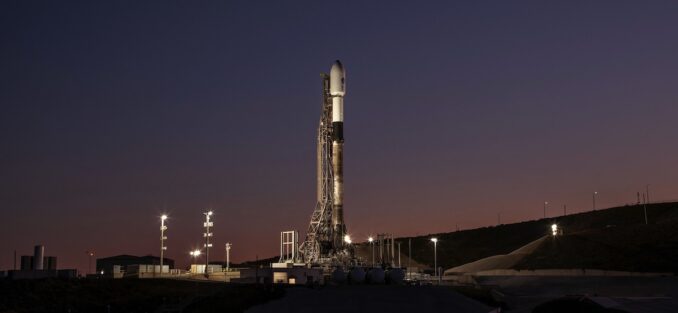
SpaceX is set to try to launch a Falcon 9 rocket from the West Coast carrying 22 Starlink satellites at 1:20 a.m. PST Sunday (4:20 a.m. EST / 0940 UTC Monday).
Early Sunday morning, the countdown for the Falcon 9 was stopped with just minutes remaining. SpaceX mentioned it was “standing down” in a social media post about seven minutes after the planned liftoff time, without giving a reason for the halted launch attempt. The Starlink 7-7 mission had already been postponed by a day.
On this 55th Starlink delivery mission of the year, the Falcon 9 will travel in a south-easterly direction after taking off from Space Launch Complex 4E at Vandenberg Space Force Base in California, aiming for a 183×178 mile (295×286 km) orbit, inclined at 53 degrees to the equator.
Spaceflight Now will provide live coverage of Falcon 9 liftoff in our Launch Pad Live stream.
The first stage booster, on its 15th flight, has previously been used for the Sentinel-6 Michael Freilich, DART, Transporter-7, Iridium OneWeb, and the Space Development Agency Tranche 0B missions, as well as nine previous Starlink delivery missions. After its burn, the first stage will land on the drone ship ‘Of Course I still Love You’ stationed about 400 miles downrange (644km) in the Pacific Ocean off the coast of Baja California.
If all goes as planned, deployment of the 22 V2 Mini Starlink satellites will occur just over an hour after launch. The V2 Mini model was introduced earlier this year and is much larger than the V1.5 satellites. Equipped with upgraded antennae and larger solar panels, the latest models can deliver four times the bandwidth of the previous satellites.
SpaceX recently announced it had signed up over two million subscribers in more than 60 countries for its Starlink internet service. Since 2019, it has launched 5,445 satellites according to statistics compiled by Jonathan McDowell, an astronomer at the Harvard-Smithsonian Center for Astrophysics, who maintains a space flight database. Of those satellites, 5,078 remain in orbit and 5,041 appear to be working normally.

